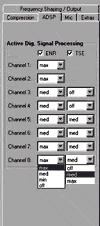Back to Basics | April 2016 Hearing Review
Initially when writing this column, I was intending to write about musicians who wanted to have control over their hearing aid parameters, or at least be able to adjust some of those parameters in their own studios or at home. I had written about this in my blog in early 2014.1
I figured that the worst-case scenario resulting from self-adjustments to hearing aids would be a few musicians returning to my office with the request that I optimize their hearing aid fittings after they had finished playing with the controls. This scenario got me to thinking about which parameters we hearing healthcare professionals might allow the musician to have some control over.
Like many of my colleagues, I have been reading through the dozen or so pages of the President’s Council of Advisors on Science and Technology2 letter report about hearing aid delivery. Specifically, I was interested in what the report referred to as a “basic” hearing aid. The “basic” would be for those hard-of-hearing (HOH) consumers with a mild or moderate hearing loss.
The one parameter I would not give up control over is the maximum output of the hearing aids (OSPL90). This parameter has to be fit according to an individual’s frequency-specific tolerance levels, and this is something that only a hearing healthcare professional can fit.
Conceivably, I could set and verify the OSPL90 setting and then give the musician (or other audiophile) a brief lesson in electro-acoustics. I would ask them to keep the compression ratio below 3:1, the frequency response according to their audiometric configuration—narrow for steeply sloping hearing losses, and broad for flatter and milder hearing losses—and gain being between 25-35% of the audiometric threshold. These guidelines would at least keep them in the ballpark.
With this “thought experiment” in mind, if in the future an alternative hearing aid delivery system is used that perhaps does an end-run around the audiologist, it is crucial that the hard-of-hearing consumer should not have access to the OSPL90. Imagine a world where “basic” hearing aids were sold over the counter, and the maximum output was not specified, such as in those recommendations of the PCAST.2 Further hearing deterioration would ensue and people would not wear their hearing aids because of intolerance of louder environmental sounds, regardless of the price they paid for the aids. Taking away control of the maximum output from the audiologist doesn’t mean that HOH consumers have greater access—it just means they have a greater chance of further deterioration of their hearing and a hatred of louder environmental sounds. A higher cost with a lower price tag.
There is no way to ensure that an over-the-counter commercially available hearing aid will not produce overly intense sounds that will not damage a person’s auditory system.
Eyeglasses are for conductive losses; hearing aids are for sensorineural losses. Hearing aids are not eyeglasses. Eyeglasses correct for a myopic condition that is best described as “conductive.” The light waves are not optimally conducted to the retina, which is the sensory organ, due to an eyeball shape that is not optimal. Maximum light levels are not an issue with eyeglasses. In contrast, when it comes to hearing aids, hearing loss is primarily a sensorineural condition where a loss of acuity is coupled with a reduced tolerance for loud sounds. Hearing aids have improved dramatically over the years, but cannot correct for sensorineural hearing loss. And unlike eyeglasses, maximum sound levels are a crucial issue with hearing aids.
I think that the PCAST recommendations about a “basic” hearing aid for mild-to-moderate hearing losses are in error. Upon reviewing the PCAST report, I think they meant “hearing aids for conductive hearing loss” and not “basic.” With a conductive hearing loss, I would tend to agree that taking an over-the-counter eyeglass approach, although not optimal, is at least founded on some modicum of scientific truth. A sensorineural hearing loss is an entirely different animal, and the vast majority of hearing loss that is treatable with hearing aids is sensorineural, and not conductive.
There is no maximum output (eg, OSPL90) measure that is immune to Boyle’s Law: the smaller the volume, the greater the pressure. Smaller volume ear canals and those with higher impedance middle ear systems “see an acoustic load” that generates higher level sound pressures. Without verification of a hearing aid by a hearing care professional, there is no way of knowing how much sound is getting into the ear canal and what the maximum level is. And, there can be no federal or state law that can repeal Boyle’s Law.
References
-
Chasin M. What hearing aid parameters can we allow the musician to self-adjust? Feb 11, 2014. Available at:
http://hearinghealthmatters.org/hearthemusic/2014/hearing-aid-parameters-can-allow-musician-self-adjust/ -
President’s Council of Advisors on Science and Technology (PCAST). [Letter.] October 2015. Available at: http://www.whitehouse.gov/sites/default/files/microsites/ostp/PCAST/pcast_hearing_tech_letterreport_final2.pdf
Marshall Chasin, AuD, is an audiologist and director of research at the Musicians’ Clinics of Canada, Toronto. He has authored five books, including Hearing Loss in Musicians, The CIC Handbook, and Noise Control—A Primer, and serves on the editorial advisory board of HR. Dr Chasin has guest-edited three special editions of HR on music and hearing loss (August 2014, February 2009, and March 2006), as well as a special edition on hearing conservation (March 2008).
Correspondence to: [email protected]
Original citation for this article: Chasin M. Back to Basics: A Closer Look at PCAST’s Problematic Definition of “Basic” Hearing Aids. Hearing Review. 2016;23(4):12.?
Image credits: Marshall Chasin; copyright Dreamstime






